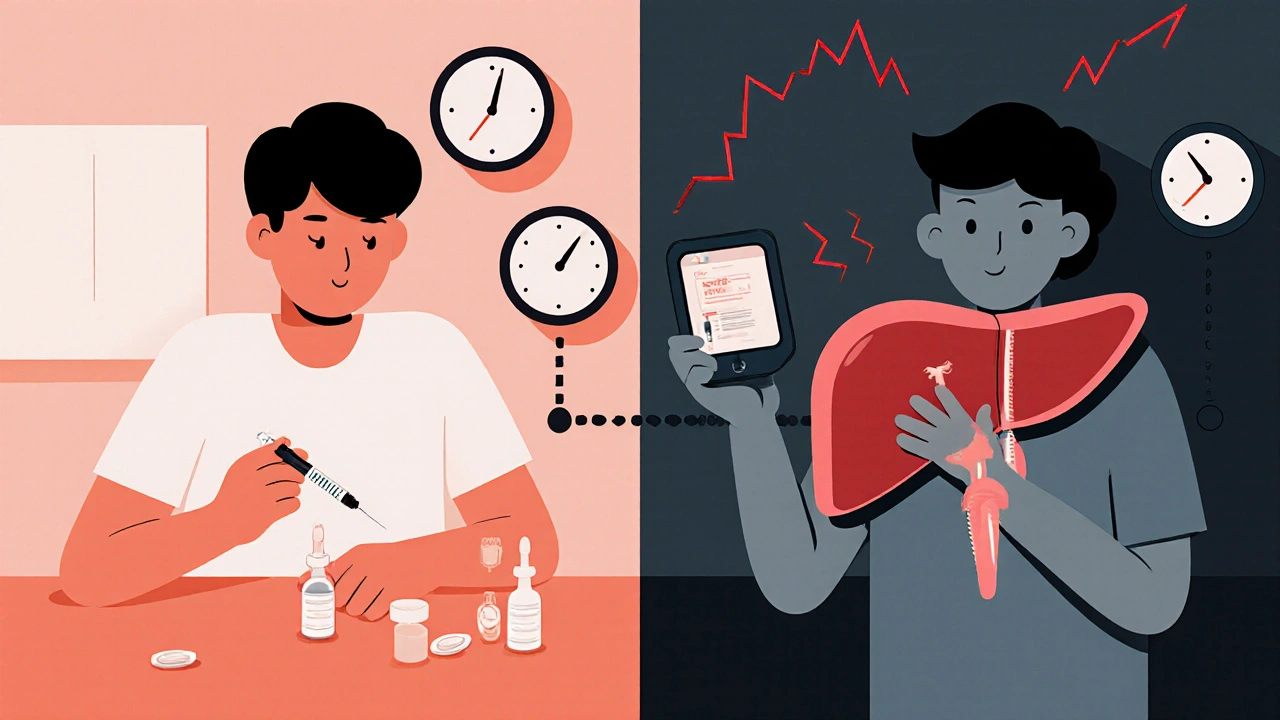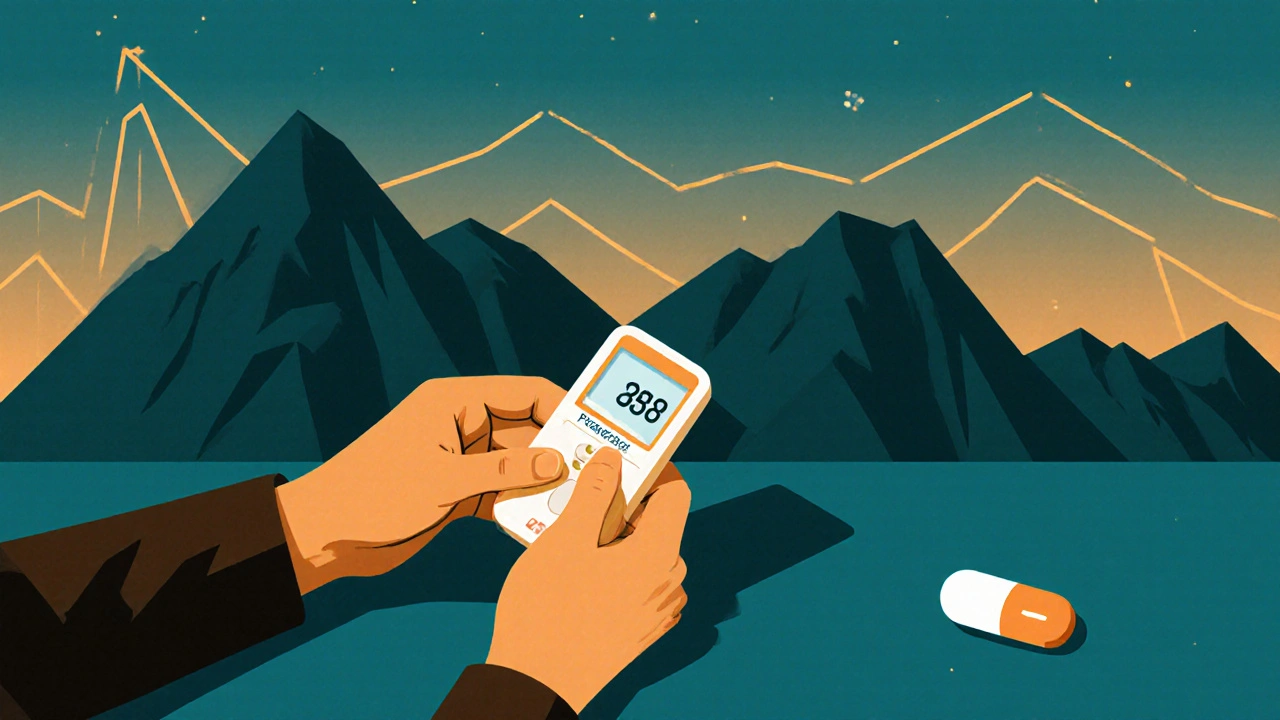Steroid-Induced Hyperglycemia Insulin Calculator
Calculate Your Insulin Needs During Steroid Therapy
This calculator helps determine appropriate insulin dosing based on your steroid type, weight, and current blood sugar levels. Always consult your healthcare provider before adjusting medications.
For starting insulin: Begin with 0.1 units per kilogram of body weight.
For mealtime insulin: Use 0.04 units per kg if between 11.1-16.7 mmol/L (200-300 mg/dL), or 0.08 units per kg if above 16.7 mmol/L (300 mg/dL).
For tapering: Reduce basal insulin by 10-20% every 2-3 days as steroid dose decreases.
When you're prescribed steroids like prednisone or dexamethasone for inflammation, asthma, or an autoimmune flare, the last thing you expect is your blood sugar to skyrocket. But for people with diabetes - or even those without - this is a common and dangerous side effect. Steroid-induced hyperglycemia isn't just a nuisance; it can lead to diabetic ketoacidosis, hospitalization, or long-term nerve and kidney damage if not managed properly. The good news? It’s predictable. And with the right adjustments, you can avoid the spikes and the crashes.
Why Steroids Raise Blood Sugar
Steroids don’t just reduce swelling. They interfere with how your body uses insulin. They make your liver pump out more glucose, even when you don’t need it. They block insulin from working properly in your muscles and fat. And over time, they wear down your pancreas’s ability to make enough insulin. This combo - more sugar in, less insulin working - is why your blood sugar jumps within hours of taking a steroid dose. The timing matters. Blood sugar typically starts rising 4 to 8 hours after you take your steroid, peaks around 24 hours, and doesn’t drop back down until 3 to 4 days after you stop. If you’re on prednisone, the effect lasts about 18 to 36 hours. Dexamethasone? That one sticks around for up to 72 hours. This isn’t random. It’s pharmacology. And if your diabetes meds don’t match that rhythm, you’re flying blind.Insulin Is the First-Line Tool - Here’s How to Use It
For most patients - especially those in the hospital or on high-dose steroids - insulin is the only reliable option. Oral meds like metformin or GLP-1 agonists just can’t keep up with the speed and severity of steroid-induced spikes. Start with a baseline. If you’re new to insulin, begin with 0.1 units per kilogram of body weight. So if you weigh 70 kg, that’s about 7 units total, split between basal and bolus. But don’t guess. Use this as a starting point and adjust fast. Insulin timing must match your steroid schedule. If you take prednisone in the morning, your insulin needs to cover the peak at night. That’s why NPH insulin - which lasts 12 to 36 hours - often works better than long-acting analogs like glargine for prednisone. For dexamethasone, which lingers for days, glargine or detemir are better choices because they provide steady coverage without sharp drops. For meals, use rapid-acting insulin like lispro or aspart. Give it right when you take your steroid. If your pre-meal glucose is between 11.1 and 16.7 mmol/L (200-300 mg/dL), add 0.04 units per kg. If it’s above 16.7 mmol/L (300 mg/dL), use 0.08 units per kg. This isn’t theory - it’s a proven protocol from the Joint British Diabetes Societies.Adjusting Insulin During Tapering - The Hidden Danger
The biggest mistake? Not reducing insulin when the steroid dose goes down. As your steroid dose tapers, your blood sugar will drop - fast. But if your insulin stays the same, you’re setting yourself up for hypoglycemia. A Johns Hopkins study found that 27% of patients on sulfonylureas during steroid tapering ended up in the ER with low blood sugar. Even insulin users aren’t safe. One Reddit user, Type1Since99, shared how his endocrinologist didn’t cut his insulin fast enough after dropping from 40mg to 20mg of prednisone. He had three severe lows in two days. The fix? Reduce insulin as you reduce steroids. Start cutting basal insulin by 10-20% every 2-3 days as the steroid dose drops. Don’t wait for your blood sugar to crash. Proactively lower it. The Waterloo Wellington Diabetes Guideline says: if you needed 20 extra units of insulin during your last dexamethasone course, start with only 10 units next time. Test, adjust, repeat.What About Oral Medications?
For mild cases - fasting glucose under 11.1 mmol/L (200 mg/dL) - and if you’re not hospitalized, some oral meds can help. Metformin is often safe and can improve insulin sensitivity. DPP-4 inhibitors like sitagliptin and GLP-1 agonists like semaglutide can also work, especially in type 2 diabetes. But avoid sulfonylureas. Drugs like glimepiride or glyburide force your pancreas to pump out insulin regardless of your blood sugar. When steroids taper, your body doesn’t need that extra insulin anymore - but the drug keeps pushing it out. That’s how you get dangerous lows hours after eating, even while sleeping. The risk is real. One study showed 27% of sulfonylurea users needed emergency care during steroid tapering. Insulin is safer.
Monitoring: More Than Just Fingersticks
Check your blood sugar at least four times a day - before meals and at bedtime. But if you’re on high-dose steroids, change doses, or feel off, check every 2 to 4 hours. Don’t wait for symptoms. Hyperglycemia can sneak up. Hypoglycemia can hit without warning. If you have access to continuous glucose monitoring (CGM), use it. Real-time CGM shows you trends, not just snapshots. The goal? Stay in range - 3.9 to 10.0 mmol/L (70-180 mg/dL) - at least 70% of the time. Less than 4% of your readings should be below 3.9 mmol/L. CGM alerts can prevent nighttime lows, especially during tapering.Special Cases: Insulin Pumps and Type 1 Diabetes
If you’re on an insulin pump, you have more control - but also more responsibility. During peak steroid effect, increase your basal rate by 25-50%. For example, if your usual basal is 1.0 unit/hour, bump it to 1.25-1.5 units/hour. But when the steroid drops, reverse it slowly. A 2022 study found that pump users who didn’t reduce basal rates during tapering had 3x more hypoglycemic events. For type 1 diabetes, expect to increase total daily insulin by 30-50%. For type 2, 20-30% is typical. This isn’t a guess. It’s based on insulin resistance levels. Your body is fighting harder. Don’t be afraid to ask for help. A diabetes educator can help you calculate your new needs.What Hospitals Are Doing Right (and Wrong)
Hospitals that use standardized protocols have better outcomes. A 2023 survey found that 68% of U.S. hospitals now have written SIHG guidelines - up from 42% in 2019. The best ones include automatic insulin dose calculators tied to steroid type, dose, and time of day. They train nurses to check glucose every 4 hours and adjust insulin before the end of shift. The biggest failure? Waiting for blood sugar to hit 16.7 mmol/L before acting. By then, damage is already happening. Proactive insulin is better than reactive insulin. And the most common error? Failing to reduce insulin during tapering. A quality study at Massachusetts General found 37% of cases involved over-treatment after steroids were stopped. That’s preventable.
Long-Term Outlook
Steroids aren’t going away. Over 10 million prescriptions are written each year in the U.S. alone. That means steroid-induced hyperglycemia will keep happening. But with better tools - CGM, predictive algorithms, and protocol-driven care - we’re getting smarter about managing it. Future systems may integrate your EHR, steroid dose, and glucose trends to suggest insulin changes automatically. For now, the best tool is awareness. Know your steroid’s half-life. Know your insulin timing. Know when to cut back.What to Do Today
If you’re starting steroids:- Check your baseline blood sugar and HbA1c.
- Talk to your doctor or diabetes educator about insulin dosing before you start.
- Use rapid-acting insulin with meals and basal insulin matched to your steroid’s duration.
- Check glucose 4+ times daily. Use CGM if available.
- Plan your insulin reductions before your steroid taper begins.
- Never stop insulin without medical advice - even if your sugar drops.
- Start reducing insulin 2-3 days before your steroid dose drops.
- Reduce basal insulin by 10-20% per reduction step.
- Watch for signs of low blood sugar - sweating, shaking, confusion - even if you feel fine.
- Keep fast-acting carbs handy at all times.
- Call your provider if you have two or more lows in 24 hours.
Frequently Asked Questions
Can I use metformin instead of insulin when taking steroids?
Metformin can help with mild steroid-induced hyperglycemia - especially if your fasting glucose is below 11.1 mmol/L (200 mg/dL) and you’re not hospitalized. But it’s not strong enough for moderate to high-dose steroids. Insulin is faster, more reliable, and safer during acute spikes. If you’re on high-dose prednisone or dexamethasone, insulin is the standard of care.
How long does steroid-induced hyperglycemia last after stopping steroids?
Blood sugar usually returns to baseline 3 to 4 days after your last steroid dose. But with dexamethasone, it can take up to 7 days because it stays in your system longer. Don’t assume your insulin needs are gone just because you stopped the steroid. Keep monitoring and reduce insulin gradually over those days.
Why do I get low blood sugar after tapering steroids?
Your body’s insulin resistance fades as the steroid leaves your system - but your insulin dose hasn’t changed. You’re still giving yourself the same amount of insulin your body no longer needs. That’s why hypoglycemia is so common during tapering. The fix? Reduce insulin doses in sync with your steroid reduction. Don’t wait for symptoms - be proactive.
Should I avoid steroids if I have diabetes?
No. Steroids are often essential for treating serious conditions like severe asthma, lupus, or rheumatoid arthritis. The goal isn’t to avoid them - it’s to manage the blood sugar side effect. With proper planning, insulin adjustments, and monitoring, you can safely take steroids without dangerous highs or lows.
Is it safe to use an insulin pump during steroid therapy?
Yes, but you need to adjust your basal rates. Increase your basal insulin by 25-50% during peak steroid effect. For example, if you take prednisone in the morning, you may need higher basal rates from late afternoon through night. When tapering, reduce basal rates slowly - over several days - to avoid lows. Always keep a backup insulin pen in case the pump fails.
What’s the biggest mistake people make with steroids and diabetes?
The most common error is not reducing insulin doses when the steroid dose goes down. Many people think once the steroid is stopped, their blood sugar will stay high - but it doesn’t. It drops fast. Keeping the same insulin dose leads to severe hypoglycemia. Studies show 30-40% of cases of preventable low blood sugar happen because insulin wasn’t adjusted during tapering.

Comments (15)